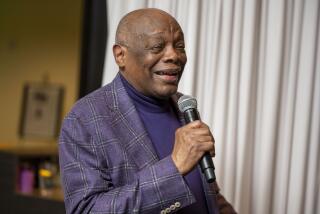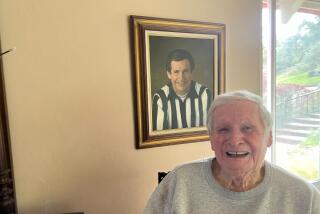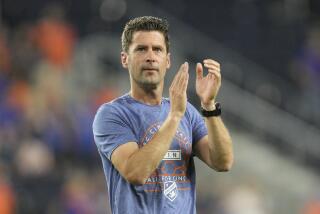This Coach Was in Class by Himself
First, there was Walter Camp. Then, Amos Alonzo Stagg. Then, Pop Warner. Knute Rockne. Vince Lombardi.
And, then, there was Paul Brown.
Football is like war. You remember the generals.
There are lots of competent ones. There are only a few great ones.
A team, like an army, is never any better than its leaders.
They all have their methods, generals and coaches. Knute Rockne, like George Patton, was a great actor.
Amos Alonzo Stagg was your kindly old uncle. He cajoled performance out of you. Lombardi screamed it out of you. You were more afraid of him than the guy across the line of scrimmage. Pop Warner was X’s and O’s. He took the game out of its punch-in-the-nose, kick-in-the-head tactic and did what Clausewitz did to battle. Made it cerebral. After Warner, you could never tell which side would win simply by adding up the tonnage.
Paul Brown simply reduced the game to a science. You might say he computerized it, except computers were unknown in his era.
Some say Paul himself was the computer. Aloof, unemotional, made of iron, he seemed to have all the warmth of a data bank. He produced football teams that were like he was, precise, meticulous, methodical, impersonal.
But they were the best football teams of their time.
He once went 4 years in high school without losing a game. Moving to Ohio State, he promptly won the national championship. At Great Lakes Naval Training Station, he put together a team that beat Notre Dame.
He’s the only guy I know of to have a team named after him. His team, spawned in a short-money league put together by a sportswriter and his pals, hardly ever lost. It turned out to be the best in the world when the lofty, older, established National Football League haughtily let it in and it promptly routed their best on the field of play.
It was interesting at last week’s Super Bowl game in Miami to see the reactions of the nation’s sporting press when Paul Brown, now the owner of the Cincinnati Bengals, was scheduled for a press conference. The younger, or the who-was-Bing-Crosby? set appeared mystified. Who was Paul Brown and why are we having a press conference with him?
A colloquy was overheard at the door. A stern patriarch of the game was tapping a boyish colleague in the chest: “You think Bill Walsh is a genius? You should have seen Paul Brown.”
Who was Paul Brown? Well, among other things, the guy who:
--First sent in all the plays from the bench. Commonplace now, it was considered heretical inBrown’s day and downright demeaning to the quarterback.
Brown didn’t care. He would have called plays by remote control but the headsets he installed in the helmets kept getting police calls from Ashtabula.
--First passed out play books with numbered assignments in the team’s own code.
--Instituted intelligence tests for players. He believed that smart players improved. The stupid player was as good as he was ever going to be right now.
--Put in the draw play, a devastating maneuver in which the quarterback slipped the ball to the fullback surreptitiously as he was ostensibly going back to pass, drawing the attention of the defense.
“You fool one guy with a trap block,” explained Brown. “You fool a whole pass rush with a draw play.”
--Put in a middle linebacker. The league played a 5-man defensive line in those days until Paul Brown dropped his agile tackle, Bill Willis, back with instructions to go where the ball goes and drop out of the pass rush. It resulted in the 4-3 defense, which has become further refined to today’s 3-4.
--First played black players--the Rams shortly followed suit. Brown anticipated the league in this move but wants no credit.
“Wouldn’t you have played Marion Motley?” he asks.
--First used a “taxi squad,” a team of reserve players to accompany the team and be pressed into service in the event of injury to regulars. Even the term originated with Brown, whose owner operated a fleet of taxicabs and furnished one free for the stand-in players.
--First used a face mask, which he invented and perfected, when his quarterback had his mouth ripped open and which has saved more teeth than fluoride.
He was a man who didn’t revel in the austere image, the almost disdainful air he was believed to project. But then, neither were his public relations the best. Paul Brown never explained. Never apologized.
The first time I ever ran into the coach was at a draft meeting in New York. I was in the magazine dodge at the time. I don’t remember if we had even begun publishing but I asked if I could sit down with him and his staff as they made their selections. I had already sat in with other clubs.
The temperature around the table dropped 30 degrees as Brown fastened his cold blue eyes on me.
“No. That won’t be possible,” he snapped.
Many years later, I found out when I read his book, “PB: The Paul Brown Story,” why he may have been so curt. Years before, in another draft meeting, he had been burned by his own assistant coach, Weeb Ewbank. Ewbank was shortly to leave for the Colts and was tipping the Colts to Brown’s draft choices.
That might have explained his churlishness. But Paul Brown didn’t think it was any of my business.
He could be said to have been his own worst enemy except that enemies didn’t bother Paul, even when he was one himself.
He just never added the grace note. His sarcasm was all-pro. When his team was going to play the lordly NFL for the first time, in fact, the NFL champs themselves, Paul recounts in his book how he curled his lip and said to his team: “Just think, today you’ll get to touch the great Steve Van Buren!”
Once when he arrived at the Baltimore stadium and the Baltimore Colts showed up puffing big stogies, he advised his players, “We can lick any team that gets off a bus smoking cigars.”
He used to throw wet towels at any players he caught nodding in team meetings and didn’t always bother to sort his men out. Once when he had a couple of backs named Don Shula and Carl Taseff, one of them made a great tackle on Marion Motley in practice. Brown bent over to help him up.
“Great tackle, Taseff,” he said.
The tackler looked up groggily. “Shula,” he said.
He had great players. But they had a great coach.
He was taken aback last week when he came to the press room and found it jampacked, standing room only. You knew Paul Brown was surprised because he showed up in an open-neck shirt and visored cap. Ordinarily, the most proper and formal of men, Brown used to dress on the sideline as if he were in a bank.
“I just thought I was going to sit around on a sofa and talk to a few old friends,” he explained in some embarrassment.
He got a standing ovation when his interview was through. A young reporter was standing in the doorway.
“I guess he was some coach,” the young man offered.
“Look at it this way,” an old-timer told him. “Bill Walsh worked for him--for 8 years.”
More to Read
Go beyond the scoreboard
Get the latest on L.A.'s teams in the daily Sports Report newsletter.
You may occasionally receive promotional content from the Los Angeles Times.










